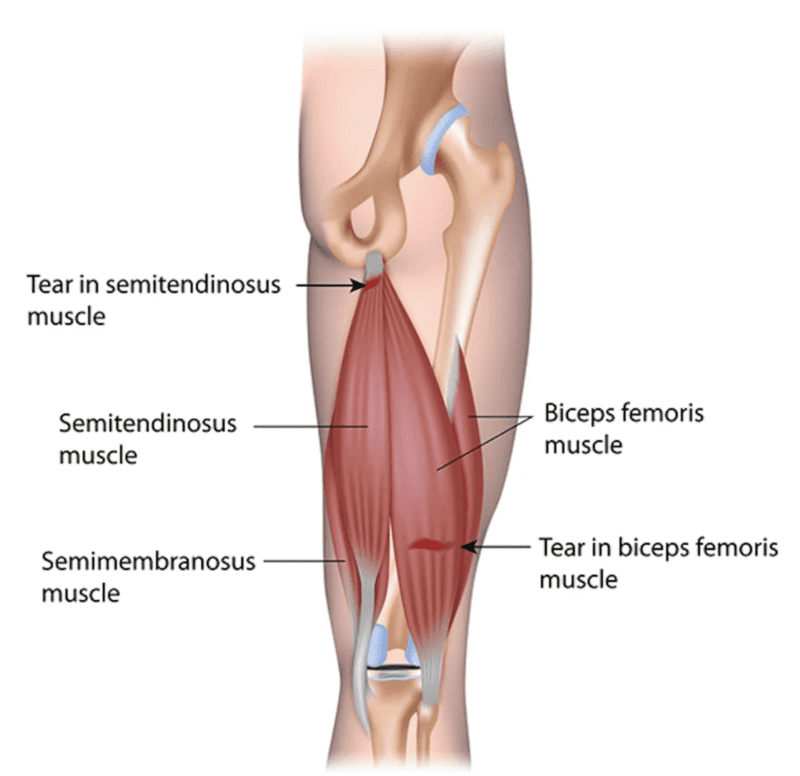Struggling with hamstring pain during Sunday league football?
Hampered with a niggly thigh during any athletic hobby/endeavour?
Or are you someone who struggles with posterior thigh pain despite not being involved in any sports?
Hamstring pain is a common phenomenon, leading to up to 22% of football players losing time to injury (Ahmad et. al, 2014) and even extends to other sports such as dancing and running (Danielsson et. al, 2020).
Importantly as well, hamstring injuries and tears also occur in non-sporting populations, particularly in older females and younger populations who are not musculoskeletally mature (Kuske et. al, 2016). These injuries can also have a detrimental impact on your ability to perform at your best in the workplace.
Therefore, understanding not only how hamstring injuries occur, but how best to prevent them and bulletproof the hamstrings is probably relevant to you or someone you know/work with. In this post we will explain hamstring injuries, how they occur and evidence-based strategies to bulletproof the hamstrings to reduce the risk of these incidences.

What are hamstrings, and why do they matter?
Firstly, it’s important to understand what the hamstrings are and why they are important. The hamstrings are actually a group of 4 muscles located at the back of the thigh, which attach from your pelvic bone/back of your thigh to the back of the knee.
As you can see by its anatomy, the hamstring has a big role with regards to the knee joint. Specifically, it has a large function in bending the knee, stabilising the knee joint and generating force at the knee. This is particularly important, because movements that require our knee to be stable such as walking, sprinting, slowing down and maintaining balance on slippery surfaces are largely supported by the hamstring (along with other muscles).
In the athletic population, the hamstring is a key muscle group which is important for sprinting and decelerating. This is most common in sports such as football, rugby, track and field, etc. Injuries to the hamstrings, usually in younger populations who overload the hamstring when sprinting/slowing down, not only impact the athleticism and speed that can be generated from an athlete, but may also increase the risk of re-injury to the hamstring and knee joint if not rehabilitated and corrected.
The general population can also present with hamstring injuries, however the mechanism of injury in this population is slightly different. Though the prevalence of these are generally poorly defined, it is known that the older population greater than 60 years old often present to their general practitioner with hamstring tears (Kuske et. al, 2016). This becomes particularly relevant when we know that older populations decline in muscle mass over time, and that one of the highest mortality rate causes in the older population is through falls. Falls are certainly affected by many other variables, however given the importance of the hamstring muscle in knee stability, being proactive and having strategies to strengthen this muscle group is invariably a critical aspect of being proactive with healthy ageing.
How to prevent hamstring injuries
Before we even go into the specifics of hamstring injury prevention, it is important to understand that injuries overall are influenced by many variables. Factors such as sleep, nutrition, stress and differences in the environmental conditions are all overarching factors which may contribute to the culminating event which is an injury. Therefore, addressing these factors first and foremost is critical when looking at operating in the hamstring injury prevention space. Each factor could be a blog in itself, however general guidelines such as ensuring good quality sleep, a well balanced diet and having a sustainable stress management strategy are all key to working in a preventative space.
Although we know hamstring injuries can be experienced by both athletic and general populations, the majority of the evidence around hamstring injury prevention is based on the athletic population, which is where this will be derived.

Specifically for hamstring exercise programming, we now know that in the younger, athletic demographic, injuries occur more due to a known incident of physical exertion (sprint/delecerate etc.). A recent systematic review by van Dyk and colleagues (2019), concluded that programs which include nordic hamstring exercises can reduce injuries up to 51% in a range of sports and different athletic populations.
Similarly, exercises which focus on the lower limbs, lower back and pelvic region have also been suggested as part of a hamstring injury prevention program based on the importance of neuromuscular control (the ability to control your lower limb movements) and injury recovery (Heiderscheit et. al, 2010).
Examples of these exercises include high marches, controlled start/stop runs etc. Practically, these not only apply to athletes, but also to our general populations! Additionally, when it’s modified appropriately, the nordic hamstring exercise can be a great exercise even for non-athletic older adults.
Variations of this exercise can be included until enough strength is achieved, such as:
-
Assisted with Physio ball
-
Assisted with resistance band
-
Drop to bench height (half range)
Please remember that it’s important to work with your physiotherapist or health professional around appropriate dosing, setup and other considerations before incorporating this specifically into your routine.
Tips and Reminders for hamstring injury prevention
Work with your physiotherapist/health professional prior to jumping straight into any program!
Always remember the bigger picture! Is your sleep, nutrition and stress all managed?
Start small before going into an in depth program; progress over perfect!
Hamstring injuries can be debilitating to your athletic endeavours or hobbies, as well as your ability to work. Having a hamstring injury prevention program can be a key tool in keeping you doing the things you want to do. Organisations partnered with Employ Health can make use of proactive onsite services such as early intervention physiotherapy and preventative rehab (Prehab) for their workers who may be at risk of a hamstring injury. To learn more about Employ Health’s services, you can get in touch here.
Reach out to your Employ Health physiotherapist if there is anything we can assist with in returning you back to your best!
References:
